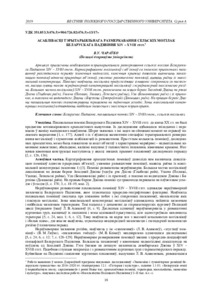Please use this identifier to cite or link to this item:
https://elib.psu.by/handle/123456789/23871Full metadata record
| DC Field | Value | Language |
|---|---|---|
| dc.contributor.author | Чараўко, В. У. | - |
| dc.date.accessioned | 2019-09-05T08:23:10Z | - |
| dc.date.available | 2019-09-05T08:23:10Z | - |
| dc.date.issued | 2019 | - |
| dc.identifier.citation | Вестник Полоцкого государственного университета. Серия A, Гуманитарные науки. - 2019. - № 9 – C. 18-21. | ru_RU |
| dc.identifier.issn | 2070-1608 | - |
| dc.identifier.uri | https://elib.psu.by/handle/123456789/23871 | - |
| dc.description | Rural Cemeteries Placement Particularity in the Belarusian Dvina Region of the 14th–18th Centuries V. Charauko | ru_RU |
| dc.description.abstract | Артыкул прысвечаны асаблівасцям тэрытарыяльнага размеркавання сельскіх могілак Беларускага Падзвіння ХIV – ХVIII стст. Картаграфаванне могільнікаў і аб’ектаў са знешнімі прыкметамі пахаванняў разглядаемага перыяду (каменныя надмагіллі, каменныя крыжы) дазволіла вызначыць лакалізацыю помнікаў адносна прыродных аб’ектаў, узаемнае размяшчэнне помнікаў, выявіць раёны іх максімальнай канцэнтрацыі. Паколькі наяўнасць могільніка прадугледжвае існаванне сінхроннага ім пасялення, маецца сувяць паміж нераўнамернай канцэнтрацыяй могільнікаў і нераўнамернай заселенасцю рэгіёна. Большая частка могільнікаў ХIV – ХVIII стст. размешчана на левым беразе Заходняй Дзвіны па рэках Дзісна (Глыбоцкі раён), Ушача (Полацкі, Ушацкі, Лепельскі раёны), Ула (Бешанковіцкі раён) і іх прытоках, а таксама на водападзеле Дзвіны і Бярэзіны (Дняпроўскай) (Докшыцкі раён). На правым беразе Дзвіны пахавальныя помнікі сканцэнтраваны пераважна на паўночным усходзе. Зоны максімальнай канцэнтрацыі могільнікаў адпавядаюць найбольш засвоеным і заселеным тэрыторыям.= The article is devoted to the rural cemeteries placement particularity in the Belarusian Dvina region of the 14th–18th centuries. The mapping of burial grounds and objects with external signs of burials of this period (stone gravestones, stone crosses) made it possible to determine the monuments localization relative to natural objects, the mutual placement of monuments, to identify maximum concentration areas of them. Since the presence of a cemetery presupposes the existence of a synchronous settlement, there is a link between the burial grounds uneven concentration and the uneven population of the region. Most of the 14th–18th centuries burial grounds located on the left bank of the Zapadnaya Dvina along the rivers Disna (Glubokoe District), Ushacha (Polotsk, Ushachi and Lepel Districts), Ulla (Beshenkovichi District) and their tributaries, as well as on the Dvina and Berezina (Dnieper) watershed (Dokshitsy District). On the right Dvina bank funerary monuments are concentrated in the northeast mainly. The burial grounds maximum concentration zones correspond to the most developed and inhabited territories. | ru_RU |
| dc.language.iso | be | ru_RU |
| dc.publisher | Полоцкий государственный университет | ru_RU |
| dc.relation.ispartof | Веснік Полацкага дзяржаўнага ўніверсітэта. Серыя А, Гуманітарныя навук | be_BE |
| dc.relation.ispartof | Herald of Polotsk State University Series A, Humanity sciences | en_EN |
| dc.relation.ispartof | Вестник Полоцкого государственного университета. Серия A, Гуманитарные науки | ru_RU |
| dc.relation.ispartofseries | Серия A, Гуманитарные науки;2019. - № 9 | - |
| dc.rights | open access | ru_RU |
| dc.subject | Государственный рубрикатор НТИ - ВИНИТИ::ОБЩЕСТВЕННЫЕ НАУКИ::История. Исторические науки | ru_RU |
| dc.subject | Беларускае Падзвінне | ru_RU |
| dc.subject | Пахавальныя помнікі ХIV – ХVIII стст | ru_RU |
| dc.subject | Сельскія могільнікі | ru_RU |
| dc.subject | Belarusian Dvina region | ru_RU |
| dc.subject | Funerary monuments of the 14th–18th centuries | ru_RU |
| dc.subject | Rural cemeteries | ru_RU |
| dc.title | Асаблівасці тэрытарыяльнага размеркавання сельскіх могілак Беларускага Падзвіння XIV – XVIII стст. | ru_RU |
| dc.type | Article | ru_RU |
| dc.identifier.udc | 351.853.3(476.5)+904:726.82(476.5)«13/17» | - |
| Appears in Collections: | 2019, № 9 | |
Items in DSpace are protected by copyright, with all rights reserved, unless otherwise indicated.
